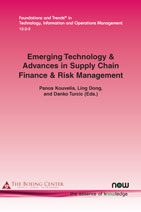Specific Capacity Investment in Supply Chains With Renegotiation
By Qiaohai (Joice) Hu, University of Missouri St. Louis, USA, joice.hu@gmail.com
Abstract
A supplier must invest and build specific capacity for its buyer to lower variable production cost long before uncertainties have been resolved. Bearing the upfront capacity and cost-reduction investment costs, the supplier under-builds the specialized capacity and under-invests in cost reduction. To resolve this issue, the supply chain partners often rely on informal agreements plus ex post renegotiation. This paper shows that neither quantity commitment only or price only initial agreement can induce the supplier to invest and build specific capacity at the channelefficient level. The supplier will over-invest but under-build the specific capacity under quantity commitment only contracts, and will under-invest but over-build the specific capacity under priceonly initial contracts. There exists an initial quantity plus price contract or option contract that induces the supplier to build the capacity and invest in cost reduction at the first-best level with or without ex post renegotiation. To improve the channel efficiency, the firms will renegotiate ex post with probability one under the quantity plus contract, but will renegotiate only if realized demand is high so that options are exercised up.
Emerging Technology & Advances in Supply Chain Finance & Risk Management
Emerging Technology & Advances in Supply Chain Finance & Risk Management reflects the state-of-the-art in research thought leadership in supply chain finance and risk management, and it contains great expository pieces on how advanced technologies are shaping supply chains and risk management within them. You will also find ideas on how supply chain finance and risk management can be best taught in our classrooms.
The volume is divided into three parts, each part reflecting a major active research area of the field including: Part 1: Supply Chain Finance; Part 2: Financial Hedging and Commodity Risks; Part 3: Operational Strategies and Risk Management.
Part 1 deals with the broad area of supply chain finance and programs that will better allow for working capital management within supply chains. Part 2 introduces concepts of hedging financial and operational risks due to uncertain commodity prices, fluctuating exchange rates, and volatile interest rates. Emphasis is placed on understanding how financial hedges can be used for hedging relevant supply chain risks in a way that reflects modern view of financial risk management. Part 3 examines topics and solution approaches reflecting the more traditional treatments in the contemporary literature of operational and supply chain risks. This volume provides rich implications for future research directions in efforts to master the new complexities and uncertainties of the global business environment and better understand the impact of advanced technologies in global supply chains.

Companion
Foundations and Trends® in Technology, Information and Operations Management, Volume 12, Issue 2-3 Special Issue: Emerging Technology & Advances in Supply Chain Finance & Risk Management
See the other articles that are also part of this special issue.